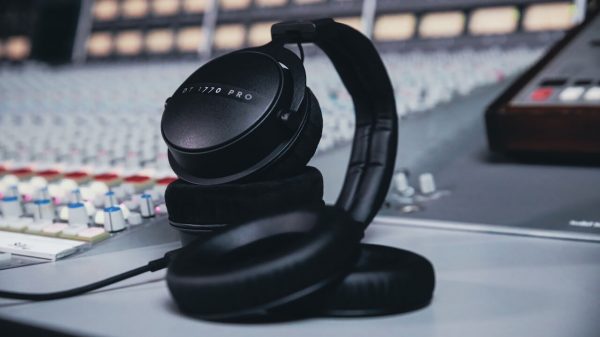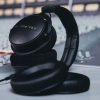Did the pandemic completely change your perspective on working from home? Tens of millions of American workers were forced to pivot almost overnight to a new working reality for almost 2 years in some locations and that same scenario was repeated all over the globe. Most people have returned to the office, but things are never going to be the same; take a hard look at the commercial vacancy rates in cities like New York, Toronto, and San Francisco and it’s rather apparent that the RTO movement hasn’t been universally successful. Is there really a need for products like the Beyerdynamic Space? We think so.
People learned how to work from home and that included setting up home offices where they could hold Zoom or Teams conference calls with entire teams and not fall behind.
Over the past 3 years, desktop audio solutions have become very popular and we were not surprised to see Audeze, Bang & Olufsen, and Beyerdynamic introduce wireless high-end speakerphones for those who live the new reality.
Having used Beyerdynamic headphones for a number of years, I have a rather intimate knowledge of their products and we’ve covered the German manufacturer over the past 2 years with a lot of news features and reviews for the simple reason that they manufacture great products that offer durability, excellent sound quality, and real value for your money.
Beyerdynamic branched out last year with new gaming headsets (DT 700 Pro X and DT 900 Pro X) and the Space Wireless Speakerphone and both of those moves made a lot of sense.
Do you need a speakerphone? I do a lot of work from home and am constantly on phone calls so the Space actually fulfills an important need in my specific situation.
I think Beyerdynamic’s advertising department has played it smart because they market the Space as a speakerphone that can also be used as a high-quality Bluetooth speaker — rather than the other way around.
This is an important distinction and I’ll explain more as we go.
Alien UFOs?

Beyerdynamic offers the Space in three different finishes and were very kind to send me a pair in Nordic Gray and Charcoal. For those looking for something less industrial looking, there is also a rather pretty looking version in Aquamarine also available.
The Beyerdynamic Space does not take up a lot of “space” and measures 5-inches in diameter and 2-inches tall.
The unit has a polymer base with a cloth wrapped top to allow both the microphones and speaker adequate airflow while providing protection from dirt and dust.

These are not waterproof so spills should be avoided wherever possible. The side of the unit includes a USB Type-C port, Kensington lock port, and the power button. All of other controls are located on the ring on the top.

A cutout on the bottom of the unit provides a place to store the USB adapter, but somewhat oddly, there is no provision made for the cable so grabbing the unit and running out the door may leave you short a USB cable to attach it. Fortunately, any standard USB Type-C able will work and a color-matched cable is provided for convenience.
Beyerdynamic recommends charging the Space out of the box and from completely drained it takes roughly 2.5 hours to fully charge the unit. Both of my test units came with the batteries at 75% and it took roughly an hour to get them both to 100%. In an emergency, a 10 minute charge will buy the user two hours of use.
Once fully charged, the unit is rated at 20 hours of use time which I found to be an accurate estimate when used as a phone. Using the unit as a speaker will shorten that battery life much faster.

Charging the unit requires a USB Type-C cable and one is provided along with a USB Type-A adapter for connection to a PC. The unit will charge while connected to a PC and operating as a communication device with Microsoft Teams, Webex, and Zoom.
Internally, the Space uses a 1.5-inch driver and two passive radiators for sound reproduction and what Beyerdynamic calls 360-degree Smart Mic Technology. There are four micro-electrical-mechanical-Systems (MEMS) microphones spaced around the outside of the ring that allow multiple speakers and also help remove unwanted background noises.
This is the first place I make the distinction between a speaker and a smartphone; the Space supports full-duplex audio so multiple speakers can be talking at the same time and listening to those on the other end of the line as well.
Sound Quality
So how did the Space do?
The Space supports multipoint so I paired it to my office laptop as well as my iPhone as a starting point. I also tested using a Samsung Android Smartphone and a MacBook Pro to try out every possible variable.
If left idle for an extended period of time, the Space will shutdown but never failed to pick right back up where it left off when I powered it back on at which point I was greeted with “Battery 70%” and “Connected.”

The control ring on the top of the unit works well to mute the speaker, adjust volume, pick-up or hang-up a call, check battery level, and Bluetooth status.
Google Assistant and Siri compatibility made it easy to ask the Space to “Call Ian White” — a task that it accomplished without any issues.
The Space doesn’t support AAC or Bluetook aptX which is another distinction between it and most Bluetooth speakers. While I would have liked to see these codecs included for higher quality audio support, I have to say that the connection was rock solid between all of my devices which of course is the primary concern with a speakerphone.
The Space uses Bluetooth 5.0 and supports the HFP and A2DP streaming profiles to ensure call quality.
I disconnected my Shure MV7 setup from my laptop for two weeks and used the Space connected to my laptop for all of my Teams calls and since I work remote that averages 4 to 5 hours daily.

The Space has very good volume and intelligibility and I never had trouble hearing others and more importantly, all the feedback I got from others was that they had no issue hearing me clearly without any annoying background noise; I have a server that sits next to my desk that I use for testing and the fans can be heard quite easily on lesser quality systems.
Another useful feature was the Space’s ability to switch between sources on the fly. Even when hardwired to the PC via USB, the Space would answer calls on my iPhone or Android and then switch back to the PC for my next teams meeting with no intervention needed. You are unlikely to have such luck with other Bluetooth loudspeakers.
When used for music listening, the Space has a nice clear presentation although it does struggle a bit with bass depth due to its diminutive size. One surprise was that the Beyerdynamic Space did not distort when I pushed the volume to the highest level.
Another limit of most Bluetooth speakers is the absence of true stereo operation and that is why Beyerdynamic sent two units for us to review.
If you have a pair of Space speakerphones, pressing and holding the multi-function button and Bluetooth button for 3 seconds on the primary unit and then again for 3 seconds on the secondary unit will put the two into cascade mode and create a stereo pair.
Touching the two buttons a second time for one second will remove the device from the cascade and allow independent use. When cascaded, all function keys impact both units so adjustment of volume, answering calls or even turning off the units can be done by pressing the buttons on a single unit.
This function worked well and allowed a pair of Space speakerphones to be used for impromptu music during lunch at the office or while on the go.
There is also a stealth mode for using the Space at night or during presentations where the light can be distracting; a business mode that only allows a single device pairing and forgets immediately on disconnection rather than keeping a list of paired devices, and a sound-aware mode where sound can be used to turn on the device.

Conclusion
Nobody should be surprised that the Beyerdynamic Space Speakerphone achieves everything that one could ask of this product. The company has a strong track record going back decades of engineering excellence and those who use their headphones for both casual listening and studio work know that they don’t introduce a product unless it’s going to fill a void and prove to be durable.
Not only were we impressed with it as a Bluetooth loudspeaker, but it proved to be the best speakerphone we’ve tried so far. The Audeze FILTER is another excellent option but the Beyerdynamic is $75 cheaper and a much better deal.
If Beyerdynamic can add support for aptX or aptX HD to the Space 2 — it will be far ahead of anything we’ve tried for the desktop in this category. As it stands right now — this is the one to buy.
Where to buy: $179 at Amazon | beyerdynamic.com

































